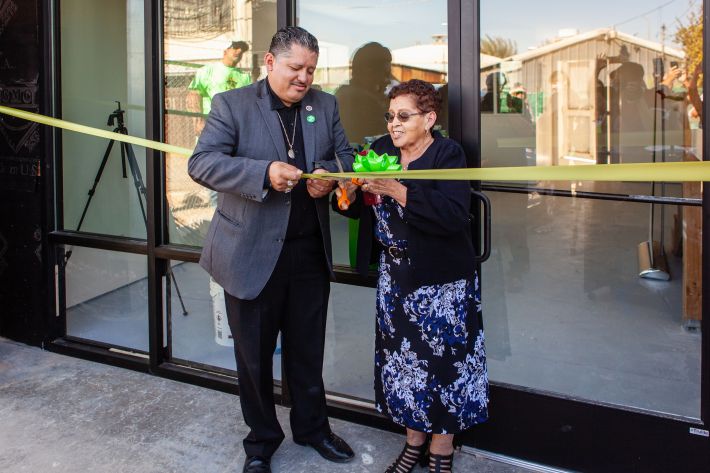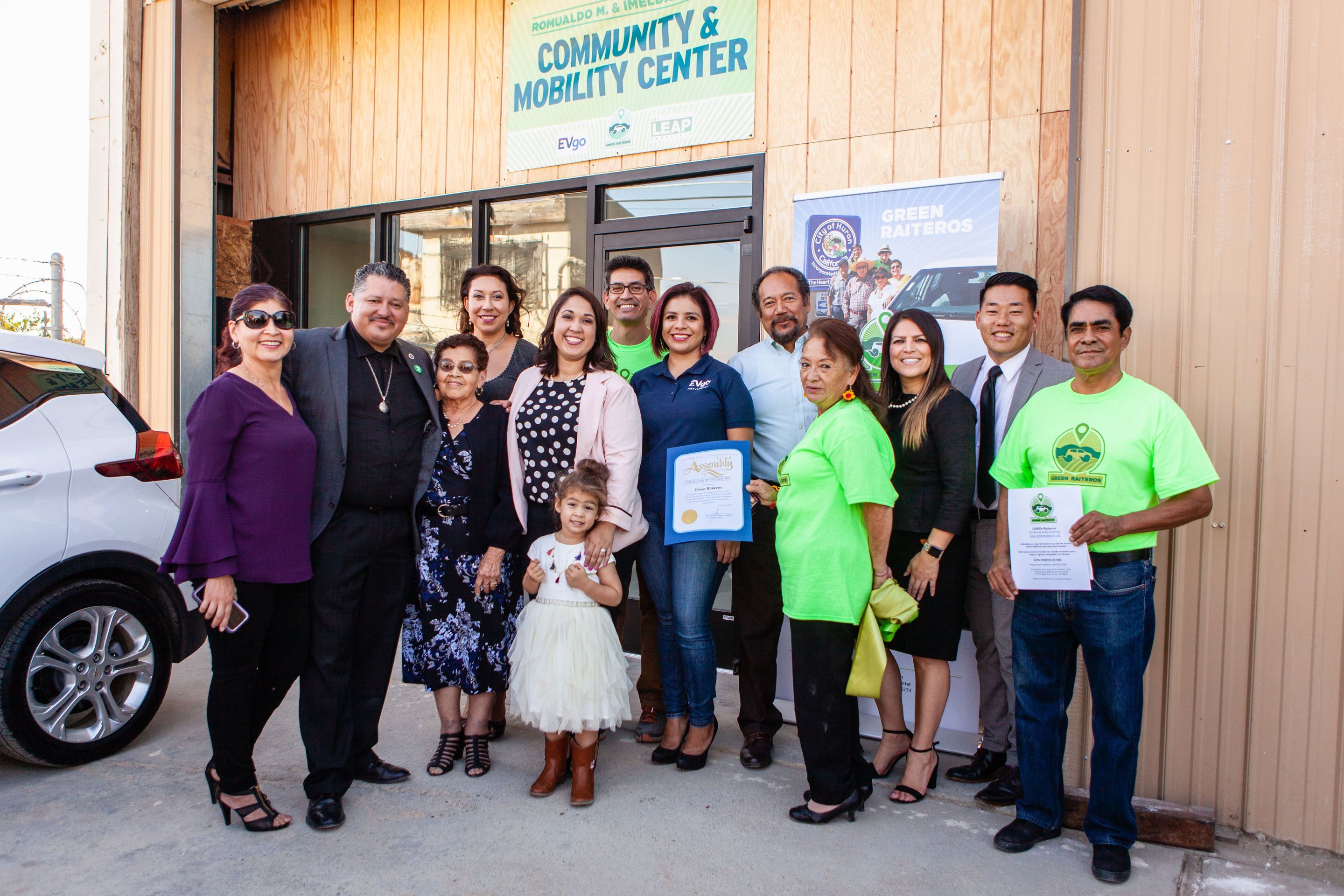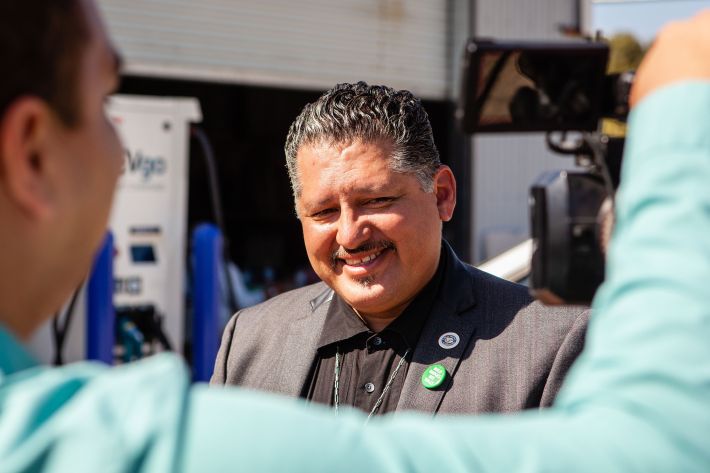Huron is a small town in the heart of the Central Valley. That's literal--ten miles or so south and east of Harris Ranch, it's about the halfway point for drivers making the trek between Los Angeles and the Bay Area. But culturally and economically, Huron is about as far from the touristic setting of Harris Ranch as you can get.
Huron's residents are mostly farmworkers, many of whom have lived in the area for generations. Not only does the entire region suffer from some of the worst air quality in the nation, being surrounded by farms doesn't so much lend it a bucolic setting as one filled with dust, pesticides, and, according to residents, asbestos in nearby streams. The region has some of the highest asthma rates in the state, and residents do hard physical labor for not very much money.
Many people living in Huron do not have access to a car. And to reach medical or social service appointments, they have to somehow get to Fresno, which is about fifty miles away. That's an hour's drive in a car--or a three- to four-hour trip on a bus.
For years, Huron residents have helped each other get to medical and other appointments, and shopping trips, using an informal ride-sharing system they call “raiteros.”
The word is a loose Spanish borrowing from the English word “ride,” and raiteros can be the people giving the rides as well as the people who ride as passengers. Long before Uber or Lyft, residents of Huron who have a car would offer rides to those without one, sharing the cost of gas and the company. They might be relatives, or neighbors, or acquaintances. Huron's mayor Rey León calls it “indigenous ingenuity.”
It was a problem that the mostly low-income community solved by itself, with its own resources.
The raiteros are doing good work, not only helping people get where they need to get in a timely way, but increasing the average number of riders per car making that long drive. However, for the most part they drive older cars that are neither clean burning or fuel efficient. That part is not good for anybody; not only do private vehicle trips account for the single largest chunk of emissions (28 percent), but there's that polluted Central Valley air.
Some of those trips to Fresno are about to get a lot cleaner, with a new program called Green Raiteros. Two new all-electric vehicles—a Chevy Volt and a BMW 13—will be made available for use by the raiteros, along with a more formal dispatch system to keep it organized. Huron recently held a celebration to launch it, which also served as the official opening for a new community center that will offer an air-conditioned spot to hang out, computers with wifi—which is not so easy to come by in the rural town—and a maintenance yard and electric charging station for the new vehicles, as well as electric vehicles that will come to Huron in the future.

The Green Raiteros program has been in the works for several years. Huron's mayor, Rey León, founder and executive director of San Joaquin Valley Latino Environmental and Advancement Policy (Valley LEAP), has been cobbling together funding—and community capacity—from a variety of sources, including grants from Just Transit and the California Endowment, and funds from a pot of money created when the CPUC settled fraud charges with an electricity company.
The money is not just for the two electric vehicles. The program launch also necessitated the installation of charging facilities in Huron and Fresno, the hiring of a program manager, and the creation of the dispatch system.
Brian Smith, an activist for clean air in the Central Valley, told Streetsblog that bringing electric cars to Huron “was a little like landing a space vehicle on the moon.”
“Just getting the power to a rural community was a major undertaking,” he said. “Green Raiteros faced many technical hurdles, but they never gave up.” Those included getting the right power lines out to Huron, which required coordinating with PG&E and EVGo, a company that is building a network of charging stations in the Central Valley. The cars have a range of 140 to 230 miles, which is enough for most round trips.
Reyes Barboza, the Director of Operations, has been working on bringing the project to reality since January. He's also a native of Huron, but spent time in the Bay Area and on the East Coast getting educated and working as a planner before returning to Huron to work on the Green Raiteros project.
Even so, he sometimes feels like a newcomer. The raiteros have been around for a long time. Many are retired or semiretired people “who for the most part have been working in the fields for their whole lives,” he said. “They want to be active community participants. One of the ways they do that is making themselves available to offer transport to others who really need it, maybe on their regular weekly trip to Fresno.”
Barboza sees the possibilities of the Green Raiteros program being a model for other areas, but wants to focus on building capacity first in his hometown. “There's a lot of talk about innovation and tech, but here you have a town that's between L.A. and S.F. that lacks a lot. We're not far from these tech capitals, and yet our fastest internet speed is DSL.”
“Without capacity,” said Barboza, “it's harder for a place like Huron to find and apply for funds for these kinds of programs, which means you have folks from outside coming in. That means there aren't any locals learning about this, and they become reliant on outside resources.”
In addition to the electric vehicles, Green Raiteros offers a dispatching service and a way to pay drivers who use their own cars for their expenses, similar to the way many volunteer organizations function. “We want to make sure we don't creep into the taxi area,” said Barboza. “We want to keep it affordable.” Drivers who use the electric vehicles won't be reimbursed, but they do get to drive the cleanest cars in town.
Eventually, says Barboza, “We can grow the EV program to establish a membership or a coop to rent the vehicles out to people” in Huron. The bigger picture, he said, is to make it part of “a farmworker community network.”
Huron is far from the only rural, farmworker-resident town in California, and the raitero system is widespread. Its informality makes it hard to know who or even where all the raiteros are, even in Huron. Part of what Green Raiteros has to offer is a model for other places to figure out how to implement a similar program to support the community as well as to clean up emissions, and other cities, such as Stockton, are watching to see how the program works out the kinks.
“Wherever there are campesinos, there are raiteros,” said Mayor León. “It's a a social network of support among comadres, compadres, neighbors, relatives, and an innate sociocultural aspect of who we are.”
Green Raiteros is “just matching it up with today's technologies, to make it easily consumable, understandable, safe, and secure,” he said.
The program is still in the process of hiring dispatchers and setting up a system, but they plan to begin offering rides this week. “The wheels are grinding slowly,” said León, “but definitely each revolution is very productive and instructional for us. We're getting rid of the air bubbles and getting rid of potholes” so other cities and towns can emulate Huron's success.
The first trips they will focus on are for medical and family services appointments. In a video about the project, and the mayor, León counts the ways Green Raiteros is an important resource for Huron in addition to the community center: it provides economic justice, serving those who need it most; it offers environmental benefits by providing cleaner transportation; it's one of many solutions for climate change; and it offers transportation justice, putting those without vehicles on an equal footing as those that have them.
The future, León told Streetsblog, is “not just about edifice or infrastructure; it's more than that. What is physical should reflect what is cultural, what is on the ground.”
“There is huge value where there's not great wealth,” he added. “That's why we need to invest in [places like Huron], so we can bring about some equity while we identify new ways to improve the larger infrastructure, transit, and other needs.”








